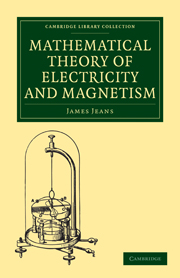Book contents
- Frontmatter
- Preface
- Contents
- Introduction
- ELECTROSTATICS AND CURRENT ELECTRICITY
- CHAP. I Physical Principles
- CHAP. II The Electrostatic Field of Force
- CHAP. III Conductors and Condensers
- CHAP. IV Systems of Conductors
- CHAP. V Dielectrics and Inductive Capacity
- CHAP. VI The State of the Medium in the Electrostatic Field
- CHAP. VII General Analytical Theorems
- CHAP. VIII Methods for the Solution of Special Problems
- CHAP. IX Steady Currents in Linear Conductors
- CHAP. X Steady Currents in Continuous Media
- MAGNETISM
- ELECTROMAGNETISM
- INDEX
CHAP. IX - Steady Currents in Linear Conductors
from ELECTROSTATICS AND CURRENT ELECTRICITY
Published online by Cambridge University Press: 05 August 2011
- Frontmatter
- Preface
- Contents
- Introduction
- ELECTROSTATICS AND CURRENT ELECTRICITY
- CHAP. I Physical Principles
- CHAP. II The Electrostatic Field of Force
- CHAP. III Conductors and Condensers
- CHAP. IV Systems of Conductors
- CHAP. V Dielectrics and Inductive Capacity
- CHAP. VI The State of the Medium in the Electrostatic Field
- CHAP. VII General Analytical Theorems
- CHAP. VIII Methods for the Solution of Special Problems
- CHAP. IX Steady Currents in Linear Conductors
- CHAP. X Steady Currents in Continuous Media
- MAGNETISM
- ELECTROMAGNETISM
- INDEX
Summary
PHYSICAL PRINCIPLES.
If two conductors charged with electricity to different potentials are connected by a conducting wire, we know that a flow of electricity will take place along the wire. This flow will tend to equalise the potentials of the two conductors, and when these potentials become equal the flow of electricity will cease. If we had some means by which the charges on the conductors could be replenished as quickly as they were carried away by conduction through the wire, then the current would never cease. The conductors would remain permanently at different potentials, and there would be a steady flow of electricity from one to the other. Means are known by which two conductors can be kept permanently at different potentials, so that a steady flow of electricity takes place through any conductor or conductors joining them. We accordingly have to discuss the mathematical theory of such currents of electricity.
We shall begin by the consideration of the flow of electricity in linear conductors, by a linear conductor being meant one which has a definite cross-section at every point. The commonest instance of a linear conductor is a wire.
Definition. The strength of a current at any point in a wire or other linear conductor, is measured by the number of units of electricity which flow across any cross-section of the conductor per unit time.
- Type
- Chapter
- Information
- Mathematical Theory of Electricity and Magnetism , pp. 300 - 340Publisher: Cambridge University PressPrint publication year: 2009First published in: 1908

